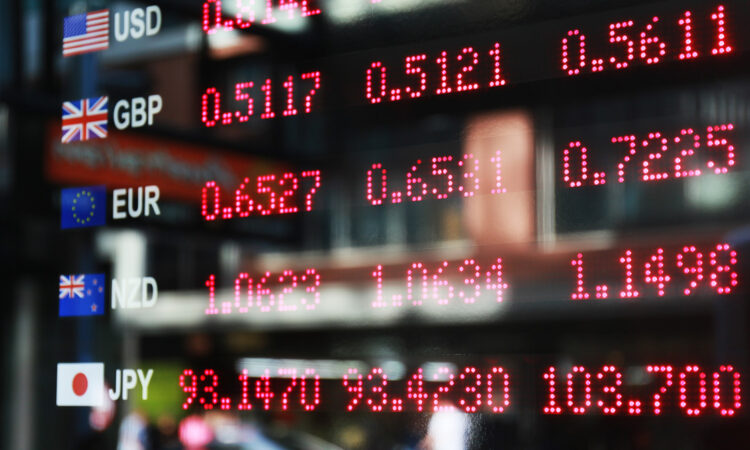
Turnover in global foreign exchange (FX) averaged more than $7.5 trillion per day in April 2022 amid a volatile market environment. Compared with the previous BIS Triennial survey in 2019, trading volumes were higher because of greater activity in short-maturity FX derivatives and more inter-dealer trading. By contrast, trading with customers stagnated, mirroring a slowdown in international investment in 2022. A greater share of trading was executed via various bilateral methods, rather than via multilateral platforms that make prices available to all participants, implying that the transparency of the FX market may have decreased further. 1
JEL classification: C42, C82, F31, G12, G15.
Turnover in global foreign exchange (FX) markets reached $7.5 trillion per day in April 2022 (Graph 1, panel A),2 a volume that is 30 times greater than daily global GDP.3 The Triennial Central Bank Survey of over-the-counter (OTC) foreign exchange turnover (“Triennial Survey”) offers a glimpse into this vast FX market. This year in April, data collection coincided with heightened FX volatility due to a confluence of factors, such as changing expectations about the paths of future interest rates in major advanced economies, rising commodity prices and geopolitical tensions after Russia’s invasion of Ukraine.
Global FX volumes were higher compared with the previous Triennial Survey in 2019, owing to two main drivers. First, more trading in short maturity FX derivatives, which mechanically increases turnover, under the assumption that many contracts are rolled over. And the greater use of short maturity derivatives may reflect market participants’ aversion to taking on term risk in a more volatile environment. Second, more inter-dealer trading, which tends to rise with volatility. In fact, the rise in inter-dealer turnover was big enough to reverse the long-term trend of a declining inter-dealer share in global FX trading. By contrast, dealers’ trading with financial customers stagnated, mirroring the slowdown in international financial investment activity.
Key takeaways
- Turnover in global foreign exchange markets reached $7.5 trillion per day in April 2022, in a market that was more volatile than during the previous survey in 2019.
- Inter-dealer trading increased, reversing a long-run trend. By contrast, trading by dealers with customers stagnated, partly reflecting a slowdown in international investment activity.
- Trading moved further away from multilateral platforms towards bilateral methods, where information remains private, suggesting that the transparency of the FX market may have decreased further.
Trading with hedge funds and principal trading firms (PTFs), and the associated prime-brokered turnover, also declined, suggesting some reduction in activity by non-bank financial intermediaries in the FX market.
The share of FX trading using various bilateral methods, where information about the trade remains private, has increased. This reflects both inter-dealer and dealer-customer trading shifting away from multilateral platforms. In the inter-dealer market, trading volumes executed via electronic brokers, where trade attributes such as prices can be seen by all participants, have thus continued to decline. The notable shift towards bilateral forms of trading in 2022 implies a continued reduction of “visible” trading and increased market fragmentation, suggesting that the transparency of the FX market may have decreased further.
The remainder of the feature starts with a bird’s eye view of long-run trends. This forms the backdrop for discussing the Triennial results obtained this year amid more volatile markets than during previous surveys. The last two sections delve deeper into the dealer-customer and inter-dealer market segments.
The global FX market – a bird’s eye view of long-run trends
While more than 50 currencies trade globally, FX trading activity is concentrated in a few trading hubs and major currencies. The Triennial captures sales desk activity in 52 jurisdictions for 56 currencies. Yet, close to 80% of all FX trading takes place in the five FX trading hubs that are major financial centres. Furthermore, as the pre-eminent vehicle currency, the US dollar was on one side of around 90% of all FX trades in April 2022 (see Box A), a share virtually unchanged for decades.
FX trading involves both spot and derivatives, with the share of spot having been on a gradual decline over the last 10 years (Graph 1, panel B). FX swaps are the most traded FX instrument and their share increased from around 40% in 2013 to more than 50% in 2022. They are typically used by market participants to take positions, manage funding liquidity in different currencies and hedge currency risk.4 Forwards are the third most traded instrument,5 used mainly to hedge currency risk or to bet on future currency movements. Their market share has edged up gradually over time.
The FX market can be broadly characterised as consisting of a dealer-customer and an inter-dealer segment. Such a two-tier structure is typical of OTC markets, where dealers warehouse risk and serve as counterparties, ie provide liquidity, to end users. Inter-dealer trading volumes used to exceed trading volumes with customers until about two decades ago due to inter-dealer trading of inventory imbalances.6 Thereafter, various structural changes resulted in relatively less inter-dealer trading (Graph 1, panel C). Examples include more efficient inventory risk management and “internalisation”, whereby dealers match customer flows on their own books.
But the distinction between the core inter-dealer and dealer-customer market segments has become somewhat blurred over time. This reflects a proliferation of multilateral trading venues, a growing variety of execution methods, and some non-bank actors emerging as liquidity providers alongside dealers. Especially in spot markets, principal trading firms (PTFs) have become important. PTFs rely mostly on speed and automated trading strategies rather than balance sheet capacity to support their market intermediation activities. As they have morphed into liquidity providers to customers, PTFs have become an integral part of FX intermediation and a key determinant of liquidity conditions.
Aggregate FX turnover in a higher volatility environment
Comparing the results of the 2022 Triennial with the 2019 Survey is complicated by very different market environments. The 2019 Triennial covered a month in a period of subdued and falling volatility in FX markets. And ultra-low interest rates supported intermediation and liquidity provision in FX markets. The 2022 environment looks very different. Especially important for the FX market this year was the high and uncertain inflation path, driving rapid but globally diverging monetary tightening. The Russian invasion of Ukraine led to further uncertainty and market turbulence. These developments had a profound effect on international capital flows and financial market volatility, including that in currency markets.
To get a better sense of the relationship of volatility and turnover in FX markets, we benchmark the Triennial with higher-frequency series.7 This allows us to compare changes in turnover not only over three years but also on a month-by-month basis.
The higher-frequency benchmark shows that turnover increased in tandem with FX volatility in the early part of 2022 (Graph 2). At close to $8.5 trillion per day, turnover in March 2022 is estimated to have exceeded even the prior peak during the Covid-19 financial market turmoil in March 2020. In July and August this year, some divergence between volatility and turnover emerged when exchange rate volatility continued to rise while turnover did not.
The positive relationship between turnover and volatility is in line with historical relationships and not too surprising (Graph 2, panel C). In a higher-risk environment, market participants tend to adjust positions, shift towards hedging currency risk, or take more speculative positions – activities that all drive up turnover. A dispersion of beliefs about the future among investors will also drive trading volumes higher.8
That said, trading in spot did not outpace that in derivatives, as it did in previous high-volatility episodes. The monthly benchmark series spot and derivatives volumes show that, historically, it was spot trading that increased faster with volatility than derivatives trading. This is especially visible during the Covid-19 crisis in March 2020. Hence, the positive relationship of changes in volatility with changes in the ratio of spot to derivative turnover (Graph 3, panel A). This year, however, both spot and derivatives trading grew in tandem so that their ratio remained unchanged (red dots). This may reflect that in early 2022 market participants adjusted to changing expectations of a prolonged period of uncertainty.
The higher turnover in FX derivatives may reflect the increasing use of short maturities. A shift towards shorter maturities increases turnover mechanically, under the assumption that many contracts are rolled over. The more granular but lower-frequency data from the Triennial shows that the growth of turnover in FX swaps and forwards between 2019 and 2022 was due entirely to more trading in shorter tenors with maturities of one week or less (Graph 3, panels B and C). And the overnight segment, first split out in 2022, accounted for close to half of short-maturity swaps and almost a third of short-maturity forwards. As inter-dealer FX swap trading is predominantly in very short tenors, the higher inter-dealer share in 2022 is one factor behind the overall shortening of maturities.
Dealers’ trading with customers stagnates
At the broadest level, customers to reporting dealers are categorised into two groups. First, non-financial customers, such as global corporates, which make up only a small and shrinking fraction of dealer-customer turnover.9 Second, other financial institutions – a customer group that includes non-reporting banks, hedge funds and PTFs, institutional investors, and official sector financial institutions.
Dealers’ trading with customers has stagnated in dollar terms compared with three years ago (Graph 4, panel A). Given the overall growth of the market, the share of dealer-customer turnover therefore fell from 62% to 54%. Stagnant customer trading may partly reflect the risk-off environment. Contraction in international investment in early 2022 likely played a role as gross external portfolio positions contracted sharply in the first quarter of 2022.10 And whenever international investment positions have fallen historically, FX market turnover with other financial institutions has fallen too.11
Across customer segments, there was a small shift away from trading with hedge funds and PTFs. Turnover with this segment declined both in spot and derivatives. Hence, the share of hedge funds and PTFs in total turnover with other financial institutions declined from 17% to 14% (Graph 4, panel B). The associated prime-brokered turnover declined as well (Graph 4, panel C). Given high volatility, market sources suggest that hedge funds have been very active in April this year. Hence, the decline is most likely to reflect less turnover with PTFs. The Euromoney magazine rankings also show that the PTF share in (direct electronic) spot liquidity provision to clients has declined, from 32% to 28% between 2019 and 2022. The relatively more muted PTF activity could reflect a range of factors such as a reported shift by some PTFs from highly competitive and efficient FX markets to less efficient asset classes with greater arbitrage opportunities, such as crypto, dealers catching up technologically or the factors underpinning the resurgent inter-dealer market as discussed next.
A resurgent inter-dealer market
Reversing the long-run trend decline, the share of inter-dealer trading has grown significantly over the last three years, to account for more than 45% of all FX trading volumes in April 2022 (Graph 5, panel A). Such a share was last seen in the mid-2000s (see Graph 1, panel B). Inter-dealer activity gained relative ground across all three major instruments, to 40% in spot, 54% in FX swaps and 34% in outright forwards (Graph 5, panel B).
The relative rise in inter-dealer trading volumes may partly reflect the more volatile environment. Higher volatility means greater need to offset inventory imbalances with other dealers and to engage in other risk management trades.
Less inter-dealer trading is public
The inter-dealer market provides crucial information for ascertaining market conditions and obtaining reference prices for the wider FX market. The centralised structure of the electronic inter-dealer spot market has meant that this core activity and information was contained within two main inter-dealer electronic brokers (see Box B). These are organised as central limit order books (CLOBs), where information such as quantities and prices is visible to traders on the platform. And analogous to an exchange, trading on these multilateral venues is anonymous, ie the counterparty is unknown (hence they are classified as “anonymous venues” in the Triennial).12 This contrasts with many other venues in the FX market, which trade by “direct” means. In these cases, dealers, for instance, respond bilaterally to requests from customers or stream prices electronically to specific customers. Hence, conditions of trades executed by direct means are known only to the two counterparties (see Box C).
The 2022 Triennial shows a further decline of trading on inter-dealer electronic brokers – a continuation of a long-run trend (Graph 5, panel C). Even as inter-dealer spot trading increased by 43% compared with 2019, the share of inter-dealer spot turnover traded via electronic brokers declined further, from 15% to 9%. Lower spot volumes on inter-dealer electronic brokers also go hand in hand with lower PTF trading activity, as PTFs account for a significant amount of trading activity on inter-dealer brokers.13
Several drivers are behind the trend decline in inter-dealer electronic brokers. First, more inter-dealer trading via disclosed and direct means, as, for example, in the fact that smaller dealers increasingly source liquidity from big dealers for their own customers in this form. Second, internalisation, whereby dealers match customer flows on their own books, continues to substitute for inter-dealer trading (Butz and Oomen (2018)). While major FX dealers have been internalising most of their customer flows for a long time, the recent Triennial shows a further increase in internalisation ratios, particularly on the part of dealers in Asian financial centres (Graph 6, panel A).14 Third, related-party trades, ie trades between different organisational units of a single dealer, which have continued to rise to 22% of total turnover (Graph 6, panel B).15 Relatedly, the 2022 Triennial first broke out “non-market-facing” trades. These amounted to $895 billion, and their shares in the different instruments ranged between 20 and 35% of inter-dealer turnover (Graph 6, panel C).16 While internalisation and non-market-facing trades seem rather technical factors, in many cases they represent alternative choices to “going to the market”, where they would have affected market conditions.
While less “visible” trading and greater market fragmentation have so far not hampered market functioning, this development may not be without downsides. Market participants have successfully used technologies to navigate a more fragmented market. For example, customers rely on smart order routing and execution algorithms to spread large orders over time and across multiple electronic venues (Markets Committee (2020)). Yet, less visibility for trades could harm price discovery for the market as a whole. It also hinders policymakers from appropriately monitoring FX markets (see Markets Committee (2018)).
References
Bank for International Settlements (2022): “Triennial Central Bank Survey of Foreign Exchange and Over-the-counter (OTC) Derivatives Markets in 2022“, October.
Bech, M (2012): “FX volume during the financial crisis and now“, BIS Quarterly Review, March.
Borio, C, R McCauley and P McGuire (2022): “Dollar debt in FX swaps and forwards: huge, missing and growing“, BIS Quarterly Review, December.
Butz, M and R Oomen (2019): “Internalisation by electronic FX spot dealers”, Quantitative Finance, vol 19, no 1, pp 35–56.
Caballero, J, P Wooldridge and D Xia (2022): “The internationalisation of EME currency trading“, BIS Quarterly Review, December.
Chaboud, A, D Rime and V Sushko (2022): “The foreign exchange market”, in R Gurkaynak and J Wright (eds), The Research Handbook of Financial Markets, available on SSRN.
Euromoney (2022): Foreign Exchange Survey 2022.
Gopinath, G (2015): “The international price system”, NBER Working Papers, no 21646.
Lyons, R (1996): “Foreign exchange volume: Sound and fury signifying nothing?”, in J Frankel, G Galli and A Giovannini (eds), The Microstructure of Foreign Exchange Markets, University of Chicago Press.
Markets Committee (2018): “Monitoring fast-paced electronic markets“, report submitted by a Study Group, Markets Committee Papers, no 10.
—(2020): “FX execution algorithms and market functioning“, report submitted by a Study Group, Markets Committee Papers, no 13.
Moore, M, A Schrimpf and V Sushko (2016): “Downsized FX markets: causes and implications“, BIS Quarterly Review, December.
Ranaldo, A (2022): “Foreign exchange swaps and cross-currency swaps”, Swiss Finance Institute Research Papers, no 22-51.
Schrimpf, A and V Sushko (2019): “Sizing up global foreign exchange markets“, BIS Quarterly Review, December.
Varian, H (1985): “Divergence of opinion in complete markets: a note”, Journal of Finance, vol 40, no 1, pp 309–17.
Online Appendix
Technical annex
Graph 1: Adjusted for local and cross-border inter-dealer double-counting, ie “net-net” basis; daily averages in April.
Graph 2.A: Triennial Survey data are adjusted for local and cross-border inter-dealer double-counting, ie “net-net” basis; daily averages in April. See Bech (2012) for a methodological description of the benchmarking technique. Vertical lines indicate the BIS Triennial Surveys in April of 2016, 2019 and 2022.
Graph 2.B: Options price based Deutsche Bank US dollar currency volatility index (DBCVIX) average mid-price. Vertical lines indicate the BIS Triennial Surveys in April 2016, 2019 and 2022.
Graph 2.C: Triennial Survey data are adjusted for local and cross-border inter-dealer double-counting, ie “net-net” basis; daily averages in April. See Bech (2012) for a methodological description of the benchmarking technique.
Graph 3A: FX spot/derivatives based on volumes settled via CLS.
Graph 3.B: Adjusted for local and cross-border inter-dealer double-counting, ie “net-net” basis. One-day data were not collected in previous Triennial surveys.
Graph 3.C: Adjusted for local and cross-border inter-dealer double-counting, ie “net-net” basis. One-day data were not collected in previous Triennial surveys.
Graph 4: FX turnover adjusted for local and cross-border inter-dealer double-counting, ie “net-net” basis; daily averages in April.
Graph 4.C: Prime-brokered turnover includes both (i) the transactions between prime brokers and their customers as well as (ii) the resulting “give-up” trades with reporting dealers. The associated customer turnover is anywhere between a half and two thirds of the total prime-brokered turnover. See Box A in Schrimpf and Sushko (2019a).
Graph 5: Adjusted for local and cross-border inter-dealer double-counting, ie “net-net” basis; daily averages in April.
Graph 6: Adjusted for local and cross-border inter-dealer double-counting.
Graph 6.A: Volume-weighted averages using total customer spot turnover (for countries that did not report the underlying customer spot turnover, their share in total spot turnover was applied). Asian centres include Hong Kong SAR, Japan and Singapore.
Graph 6.C: Based on back-to-back and compression trades.



